Sex and Sustainability in the Sea
Air Date: Week of February 12, 2016

Sex in the Sea: Our Intimate Connection with Sex-changing Fish, Romantic Lobsters, Kinky Squid and Other Salty Erotica of the Deep is Marah Hardt’s first book. (Photo: courtesy of Marah Hardt)
The extensive ecosystem under the waves depends on the intricate, complex and mysterious mating rituals of its inhabitants. Host Steve Curwood speaks with Marah Hardt, a marine biologist and author of a new book, Sex in the Sea about some clever and unusual reproductive strategies unique to sea-dwellers and why understanding this is critical for maintaining the resource. They then discuss how lobsters communicate their readiness to mate, how some whales try to ensure their genes will persist, and how static corals in reefs manage to make more corals, and Hardt argues that success in their various methods are vital for sustainable fisheries.
Transcript
CURWOOD: The fate of the oceans and fisheries are a topic we often cover here at Living on Earth. Today we have another take on the subject, from author and coral reef ecologist Marah Hardt, co-director of the non-profit Future of Fish, which works to create a global business model for responsible fishing. And for this week of Valentine’s Day, she joins us from a sustainable seafood conference in Malta to discuss her new book, and give us her salty take on what happens below the ocean surface. Marah, welcome to Living on Earth.
HARDT: Hi there, thanks for having me!
CURWOOD: And before we do anything else, please read a passage from your book page 166.
HARDT: I would love to.
Her skin shone in the moonlight, a flash of silver against a dark beach. She knew he wanted her. She could see him desperately fighting his way toward her from amongst the crowd. She positioned herself perfectly, knowing the sight of her bound body restrained and prostrate in the sand would make him, would make all of them quiver with excitement. The first to reach her, he feverishly curled himself around her. Others soon joined him, forming their own half-circle embraces. This is what she came here for, what they had all come for.
CURWOOD: Whew! This sounds kind of hot, Marah, but I guess we need to tell people this not the beginning of your latest romance novel, although it sounds like you have a flair for that sort of thing because you're talking about your new book Sex in the Sea where you document various mating rituals and courtship tactics, the sexcapades, they sound foreign but they, in some respects, mirror our own experience as humans. And this passage that you just read us, you're describing, what, this is the shore orgy of the grunion?
HARDT: Of the grunion, yes, so these are small silver fish that can fit in the palm of your hand, and they come to shore every spring to do as you said a mass orgy on the beach. It's their strategy for reproduction and it's a really fun spectacle that folks can go down and watch anywhere along the Southern California shores into Mexico.
CURWOOD: So, as a marine biologist I guess who has this dual career, what compelled you to write this book in this creative writing style you've chosen?
HARDT: So I was at a cocktail party, I was talking to some friends. We were having one of those conversations where we were lamenting not understanding the opposite sex, so folks were saying, “Gosh, if just for one day I could be in the body of a guy just know how they think or what's going through their head”, and I made very casually this off-comment that, "I know if only we could be parrot fish." It was like you could here a needle drop. I was met with these dropped jaws and open big wide eyes and everybody said, what are you talking about? So I said, "Oh, well, you know, parrot fish, they can change sex. They start life as female and transition into males." So, I explain this a little further how this is a really common strategy for reproduction in the ocean.
People were still listening, they were still really curious, and I said, "well, you know, if you think about it, that makes things really complicated for management because we tend to like to catch the biggest fish and if you think about it, if you're catching all the big ones, you're catching all the males. So you might be leaving enough fish in the sea, but if they're all females, your reproduction is going to slow down." And it was about 20 minutes later I was refilling my wine glass and I heard someone who I had been talking to say to somebody else at the party, "did you know fish change sex? Isn't that bizarre?" And I thought -- that's it. If you talk about sex, people are curious and maybe there's a way you can talk about sex, draw their attention and then subtly weave in the message of conservation because ultimately successful sex is part of sustainability.
CURWOOD: So talk to me about the various dating games of the deep.
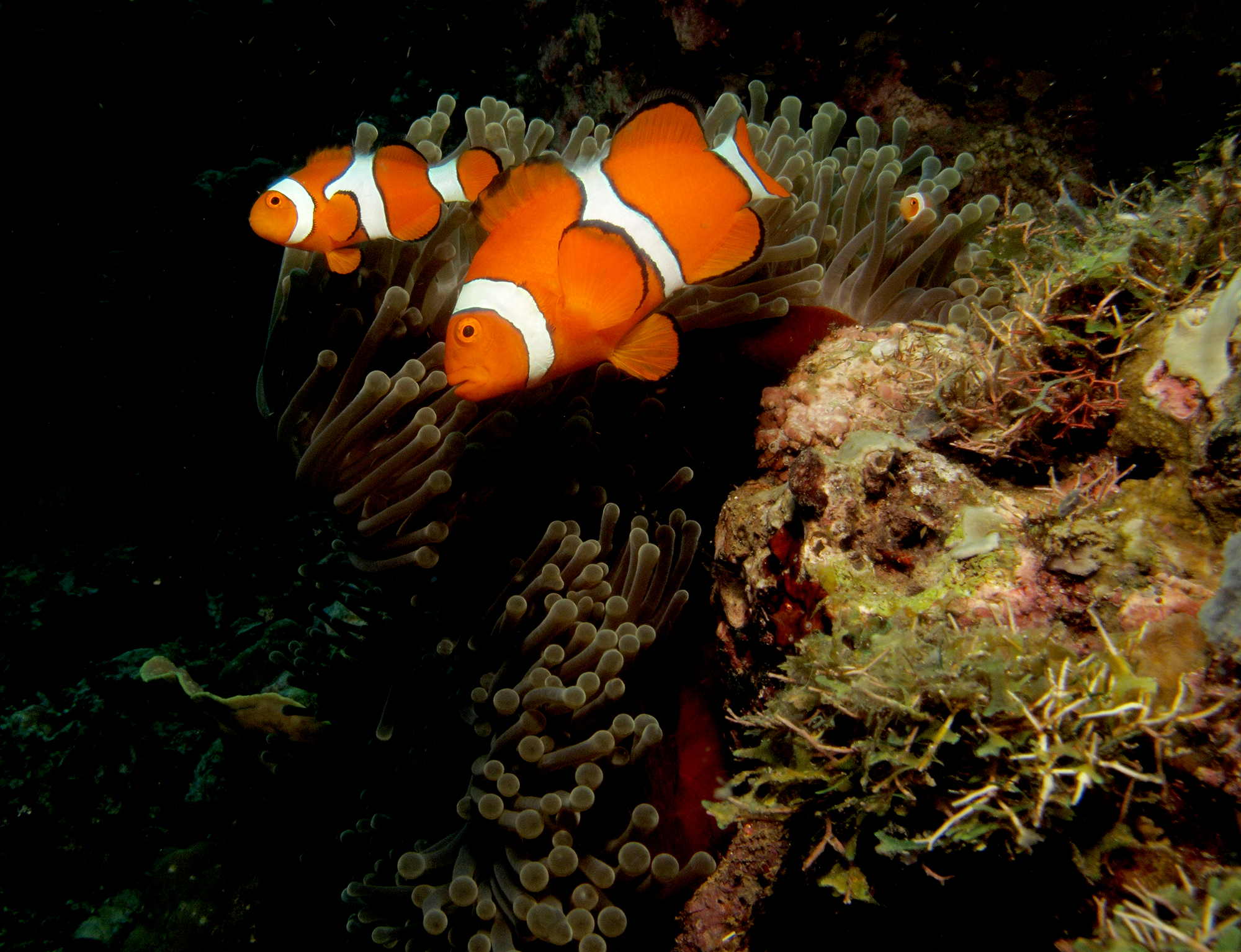
Clownfish, which mostly form in monogamous pairs, can change sex from male to female. (Photo: courtesy of Marah Hardt)
HARDT: So first, there's the search, which is how species have to find one another which in the ocean is a huge challenge. It's the largest living space on the planet, 99 percent of where animals can live is in the ocean. So, you imagine it's hard to find one another. So, that's the first challenge, and animals do this in all sorts of different ways, one of which is to do very much like what we do, which is to go to the equivalent of a singles bar or a hotspot for sex. Nassau Grouper, great example, they will travel down along the reefs. They normally live solitary lives, and they don't tend to interact with each other very much. But right after the full moon, they will move to the edge of the reef and wait and see when other groupers start passing by and they gather at the same spot every year, at the same time, they will shift their coloration and change from some desert camo pattern which is very good for ambush predators to kind of jump out on a reef and get prey and they switch more into to this black-tie affair where they'll go into a dark black mode or black with a white belly and these colors sort of signal that they're ready to be friendly and they're ready to engage more intimately and then they form these giant beautiful swirling balls and right at dusk, as soon as that light starts to change, you can see they kind of get a little fired up, they get a little antsy.
And very soon after that females are, they look pregnant, they're swollen with eggs and a female will rocket out from the group and she'll shoot towards the surface and the males will follow her and sort of form this funnel moving upwards in the water column. She releases her eggs about 10 to 20 feet below the surface and then males will streak through this cloud of eggs that she's released and they'll release their sperm. These milky clouds form and the fish sort of tumble back down in this cascading sort of geyser of fish that erupts and then falls to the sea floor and they'll move up a little bit up the reef, and do the same thing again. So you get these repeated, it's almost like Old Faithful full of fish just shoot up, explode.
CURWOOD: [LAUGHS] Fish geysers.
HARDT: Yes, fish geysers, and the visibility will go from 100 feet to where you can't even see in front of your face.
CURWOOD: So this is if they sort of they're Nassau Grouper, they're found off Bermuda?
HARDT: They're found all throughout the Caribbean, but unfortunately these days it's really hard to find them. They follow the same cues every year. In order for the fish to find one another, makes it very easy for fishers to find them, and you have all of the biggest fish clumping together all at the same time and a very predictable schedule every year it's very easy to overfish them, and so we've seen this happen again and again and again where these spawning aggregations really just get hammered.
CURWOOD: And this phenomenon, of course, allows people who fish to say, well, there are plenty of fish because they go to these aggregations.
HARDT: It looks, yeah and the abundances look absolutely huge. You can have the entire breeding population of one island in one location in one aggregation. So if you wipe that out, they're not coming in from anywhere else and it's really not until you have only a few dozen left that you realize there's no more coming anymore and that's it.
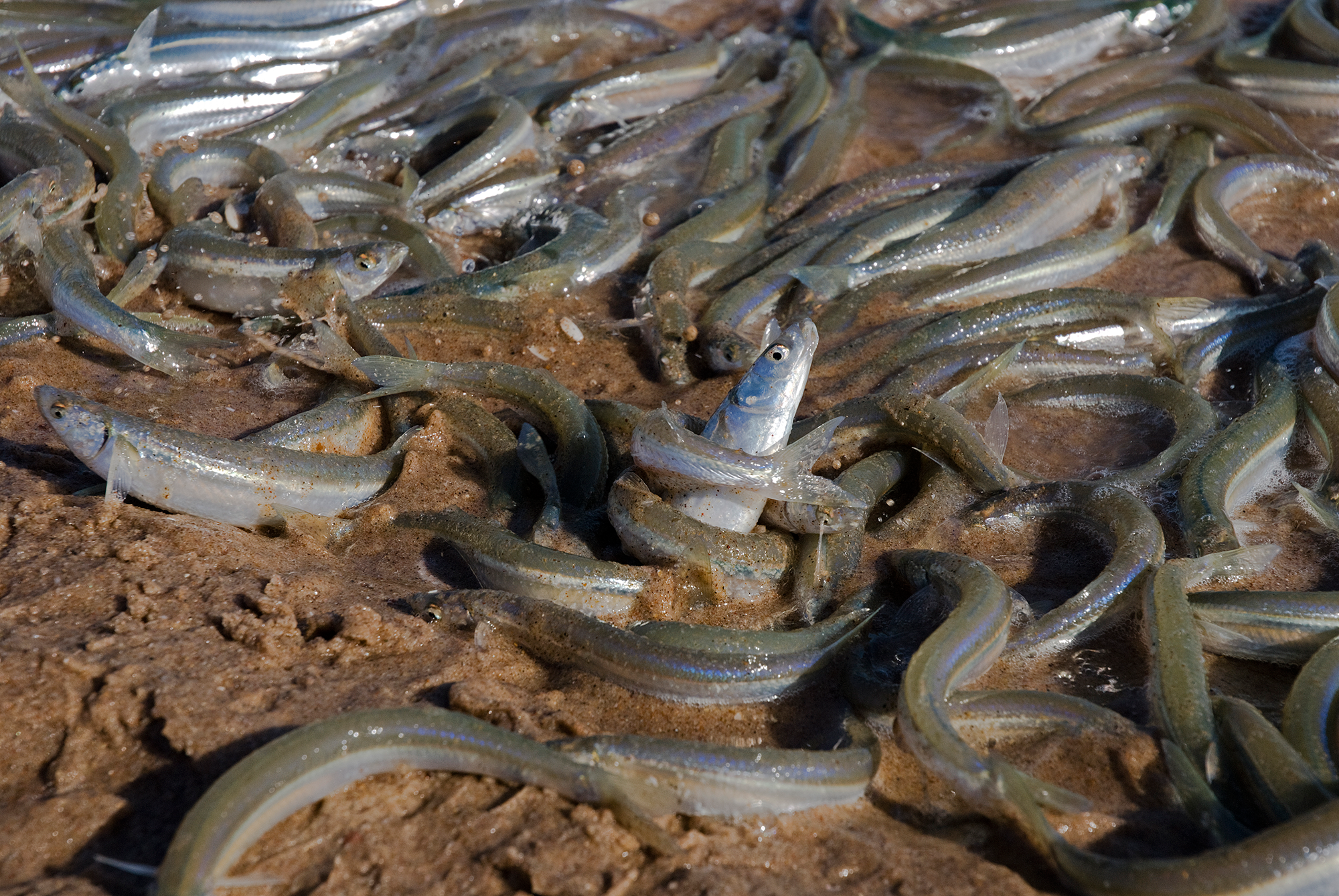
Grunion are small silver fish that come ashore every spring to mate on the beaches of Southern California. (Photo: courtesy of Marah Hardt)
CURWOOD: That’s Marah Hardt, author of the book Sex in the Sea and we’ll have more of our conversation just ahead on Living on Earth. So stay tuned.
[MUSIC: Louis Armstrong, Let's Fall In Love, on "Ella and Louis Again" by Cole Porter, Verve Records]
ANNOUNCER: Funding for Living on Earth comes from United Technologies, a provider to the aerospace and building systems industries worldwide. UTC Building & Industrial Systems, provide building technologies and supplies container refrigeration systems that transport and preserve food and medicine with brands such as Otis, Carrier, Chubb, Edwards and Kidde. This is PRI, Public Radio International.
[CUTAWAY MUSIC: New York Philharmonic/Leonard Bernstein (Aaron Copland), Quiet City, Copland: Symphony No.3/ Quiet City, by Aaron Copland Deutsche Grammophon]
CURWOOD: It's Living on Earth, I'm Steve Curwood. We continue now with ecologist Marah Hardt, talking about her new book Sex in the Sea. I asked her about her own specialty, coral reefs.
HARDT: Well, corals are these fantastic animals. They look like little anemones that are trapped in a cup, and they build these little cup houses and those houses then stitch together into apartment buildings and are then stitched together into big city blocks and then build reefs so big we can see them from space.
CURWOOD: They're the only creature we can see from space.
HARDT: Yeah, I think so. Yeah, I believe that's true, the only ones that build living structures large enough to see from space. But because they build these reefs, they're stuck. They can't move to produce. So they reproduce more like what would be almost like a plant system. They release their eggs and sperm into the water column, but the way that they do this is fantastic because you're talking about an animal that has, from our understanding, a pretty basic body plan, no big higher brain at work here and yet they organize truly the biggest orgy on the planet and it's perfectly synchronized. You can set your watch to it and in fact, researchers do every year, and it's like all of a sudden, the underwater world turns into a snowstorm, only the snowflakes rise up and are bright pink. So, the corals sit at the bottom of the sea and they release these bundles that are this bright pink coral color, and the bundles are the egg and sperm because most of the big corals that make the big reefs are hermaphrodites. And these bundles float up through the dark water column and then explode at the surface, releasing the egg and sperm and creating this giant slick of coral gametes, the term for eggs and sperm, and it all mixes and mashes at the top, and that's how you get sperm from one individual to mix with an egg of another.
CURWOOD: Except you said that when you observed this, well, that there was something really familiar about it.
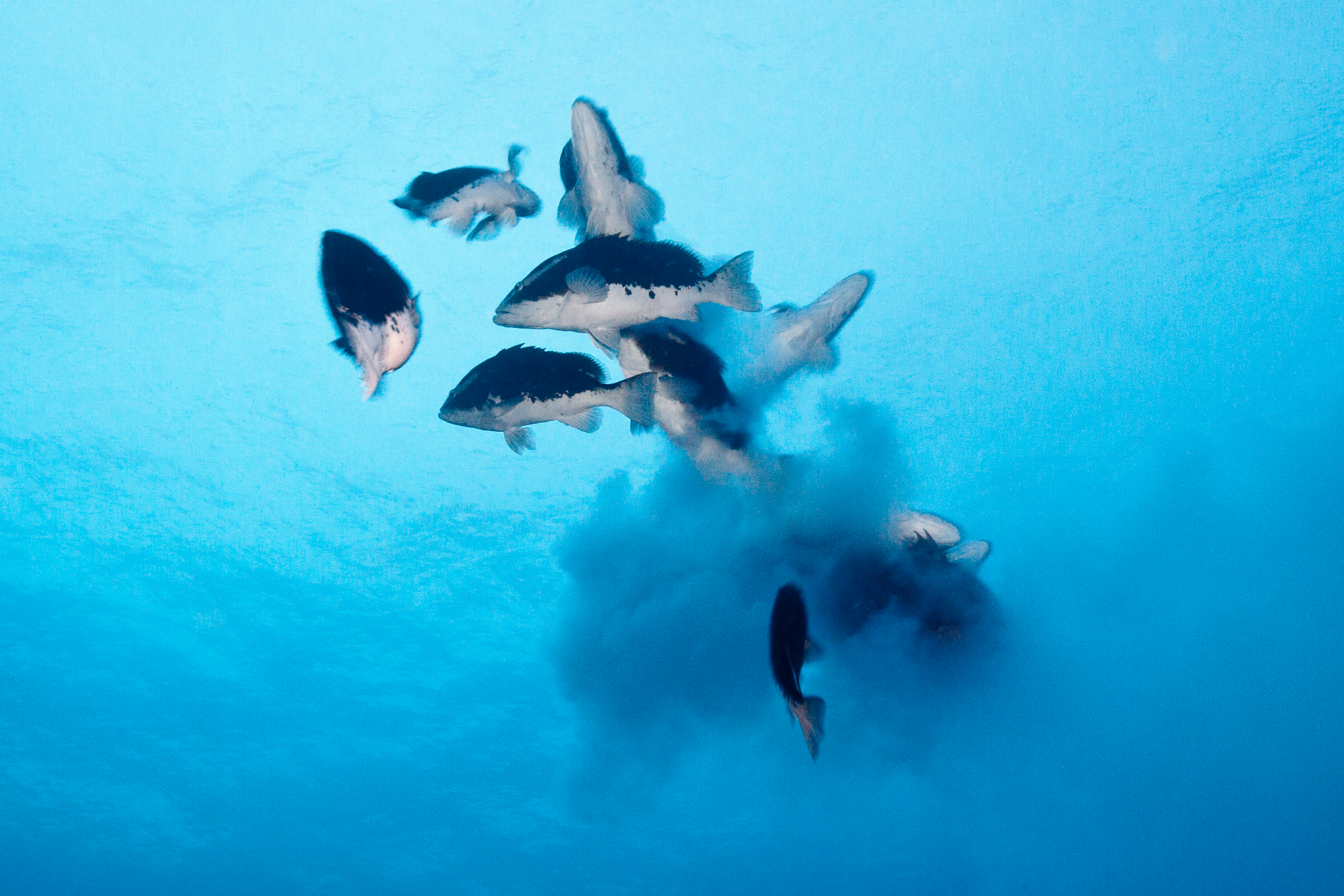
Nassau Grouper spawning. They are still found throughout the Caribbean, but their numbers are greatly diminished from overfishing. (Photo: courtesy of Marah Hardt)
HARDT: [LAUGHS] There was. So this was one of my more semi-embarrassing moments because it happened very early my grad school career. You watch the event, you come up to the surface and you come up through again this slick of coral goo and it smells very potent and very familiar of other types of sexual activity that you can sense in other animals including our own species. [LAUGHS] It's a little bit funky, and there is sort of this unspoken initiation among people who study coral sex who always look at each other and think,“Oh my gosh, this is so weird!”
CURWOOD: So talk to me about the various dating games of the deep. Now why in nature is seduction necessary?
HARDT: Well, think about the resources it takes to produce an offspring. So, females in particular have to go through a lot of energy to produce these eggs and, in many cases to raise the young, care for the young for a little while. So they want to be discerning, they want to ensure that they are making an offspring with a male counterpart who has good genes.
CURWOOD: I have to say that you have a wonderful section about lobster dating, mating and sex.
HARDT: [LAUGHS] Mmmm, lobsters are so romantic.
CURWOOD: Yeah, I had no idea.
HARDT: I know! I didn't either. What happens with lobsters...it starts off a little kinky and then it gets romantic, so bare with me, I promise we'll get to the romance. Around mating season is very aggressive. The biggest males they fight and the largest males gain dominance over the best dens. They go and kind of harass their neighbors, and they literally pee in the front door of their neighbor’s dens [LAUGHS] and it's quite rude. It's literally just to show that he can.
CURWOOD: This is like the movie "Grease" where these guys from the other group show up in their big car and they say your car is dented and broken and then after they kick it a few times, put in a few more dents, then they roar off.
HARDT: Exactly and so this is all fine and good. It helps the females identify who's the biggest and strongest, which again for her is a good thing because that's going to be good for her offspring. However, the best time for both females and males to mate is when the female molts because female lobsters have this very neat trick whereby they can lose and regain their virginity. So a female lobster has a pouch underneath her tail where she stores sperm from a male. What this means is right after she molts, she gets a new empty pouch. If she can mate right away, she feels that pouch full and then has more time to fertilize multiple batches before she grows too much and has to molt again. For the male, finding a female who has an empty pouch means he can pour all of his sperm into it and he doesn't have to share that pouch with other male sperm, so that's an advantage for him. However, for the female, when she molts, she is a soft-bodied animal, she can't even stand for the first half and hour. She is extremely vulnerable to being preyed upon or just killed.

When it is time for her to molt, a female lobster seeks out a strong male, not only to fertilize her eggs, but also to protect her when her body is soft and vulnerable to predators. (Photo: courtesy of Marah Hardt)
So what she does, she comes up with a love potion to seduce this male, and basically entrance him into becoming very gentle lover, and she does this by peeing in his face. So, she creates a stream of urine and every day will go up to his den, and spray a little bit of urine in and then she'll run away before he has a chance to be aggressive. She does this for about a week, daily little spritzes in his face, into his den. And after about a week it starts to sort of take hold. He starts to realize, oh this is a female, this is ripe female, this female is ready to do something that I think I would like to engage in. When she starts to sense that her potion has taken hold, she will move in with him and for about another week they will cohabitate, they will live together, She will go hunt, he will go hunt. And then this moment comes where she can feel that her molt is about to happen and she will walk out in front of him and do what Professor Jelle Atema calls“the knighting process”. So the female walks out and turns face-to-face with the male. And -- I should've explained lobsters, their bladders sit below their brains just behind their eyes so when they spray urine it comes out of these nozzles that are located right on their face under their eyeballs. [LAUGHTER] By coming face-to-face with her mate she can spray him most effectively and directly. She sprays him with copious amounts of urine. He sprays her back.
CURWOOD: This is an amazing golden shower.
HARDT: It is a 100 percent a golden shower. And he puts his claws down and kind of lowers his head. His big front claws go down into the sand. She lifts yourself up on her walking legs and takes one of her claws and taps him once on one shoulder and then across to the other shoulder. It really is like a knighting process and Dr. Atema says it's pretty clear the signal is don't go away, I'm about to molt, it's time to get busy. And it takes a few hours for the molting process to complete. She kind of slips out of her shell. She, again, can't stand at this point. The male all the while will sort of be near her, sometimes he will run his antennae over hers, sort of stroking her, he will tickle her, like light touches with his walking legs, just checking in on her. And again, from the female's perspective, this whole courtship process has brought her to a point where she now has the biggest toughest male not only to fertilize her eggs, but to protect her in the stage where she is so vulnerable.
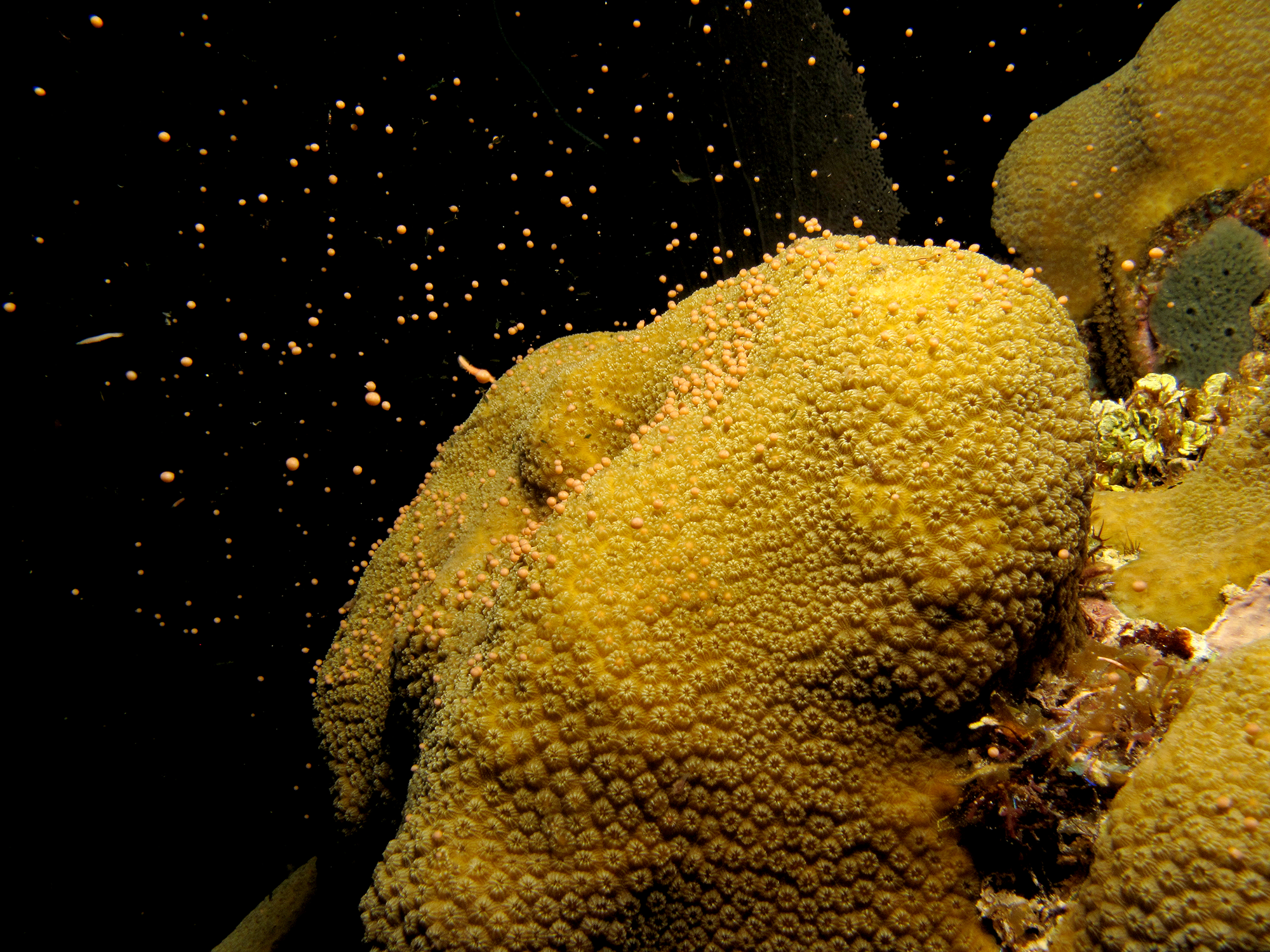
M. annularis coral spawn. Most corals, including M. annularis, are hermaphrodites and release both eggs and sperm that mix on the ocean surface. (Photo: courtesy of Marah Hardt)
CURWOOD: So the oceans are changing Marah, there's pollution like a lot more nitrogen, temperature regimes are changing, climate change. How is this affecting the sex underneath the waves?
HARDT: Well in many ways...for example the lobsters that we were speaking about, they have this very elaborate chemical communication, right, through their pee, and that requires them to be able to smell with very accurate senses, very heightened senses to smelling, and when we put pollutants in the water it can mask those chemical signals so that they can't necessarily sense what the signal is, and imagine if you're that female and you're spraying this pee and you think your potion is taking effect and then find out that the male couldn't smell you when you approach him, it's not to be a pretty situation right.
The other thing is things like ocean acidification, which is another byproduct of climate change in the ocean where we're actually changing the pH of the water, the acidity. All of the little sensors in the antenna, and antennules, they're highly sensitive to chemistry and they may be damaged or they may be reduced in their capacity in a more acidic ocean or it could be that the signals that are being produced, the way that the actual molecules in the urine react with seawater will change based on the acidity. It's as if for centuries lobsters have been writing in English to one another through their pee, but then all of a sudden with ocean acidification the letters are getting scrambled, and a male is receiving a message that he can no longer understand or read.
CURWOOD: Talk to me about the whales. Now there will probably be a giggle from some listening to us because they know that whales can have humongous organs, but I'm thinking about whales, Right whales having, well, kind of group sex.
HARDT: Yes, so looking at the anatomy of an animal can tell you a lot about the way that animal reproduces, in particular whether they tend to have many partners or not. Now, in the Right whale, they're not the biggest whale. They do not have the biggest penis, but they do have the biggest testicles on Earth. Each testes weights half a ton.
CURWOOD: That's some cojones, I would say.
HARDT: These are some serious cojones, yes. What it tells us is that it is likely that these males are having to compete with other males internal to the female. So, when we see males with these very large packages, it tends to mean that they are dumping copious amounts of sperm into that female and the reason to do that is to try to flush out the sperm of other males that may be in there or to push their fellas as far as they can. And we knew that lots of group sex was happening. But there's this fantastic - I believe they caught it on video, but there's definitely wonderful photos - where a bunch of research scientists were in their boats. They were there tagging whales and somebody saw a female come up to the surface and roll onto her back and a researcher named Dr. Phillip Clapham who is with NOAA, the National Ocean and Atmospheric Administration, tells it that it wasn't that uncommon, that you would see a female come up and roll and then a male giant pink phallus comes out of the water and will enter into her, but what happened this time was one male came up on one side and they all saw, someone yelled out, “Penis, insertion is happening everyone.” And then somebody went, "Holy smokes there's another one!" And they turn around and it's like two giant bowed penises, and these things are like six feet long. I mean they are big phalluses coming up, arching out of the water and entering into the female simultaneously. So always knew that Right whales were frisky and that there was some sperm competition going on, but if anything is going to encourage the production of gigantic testes it's going to be having to ejaculate at the same time as another male is in the female at once.
CURWOOD: It gives new meaning to the phrase "a whale of a time".
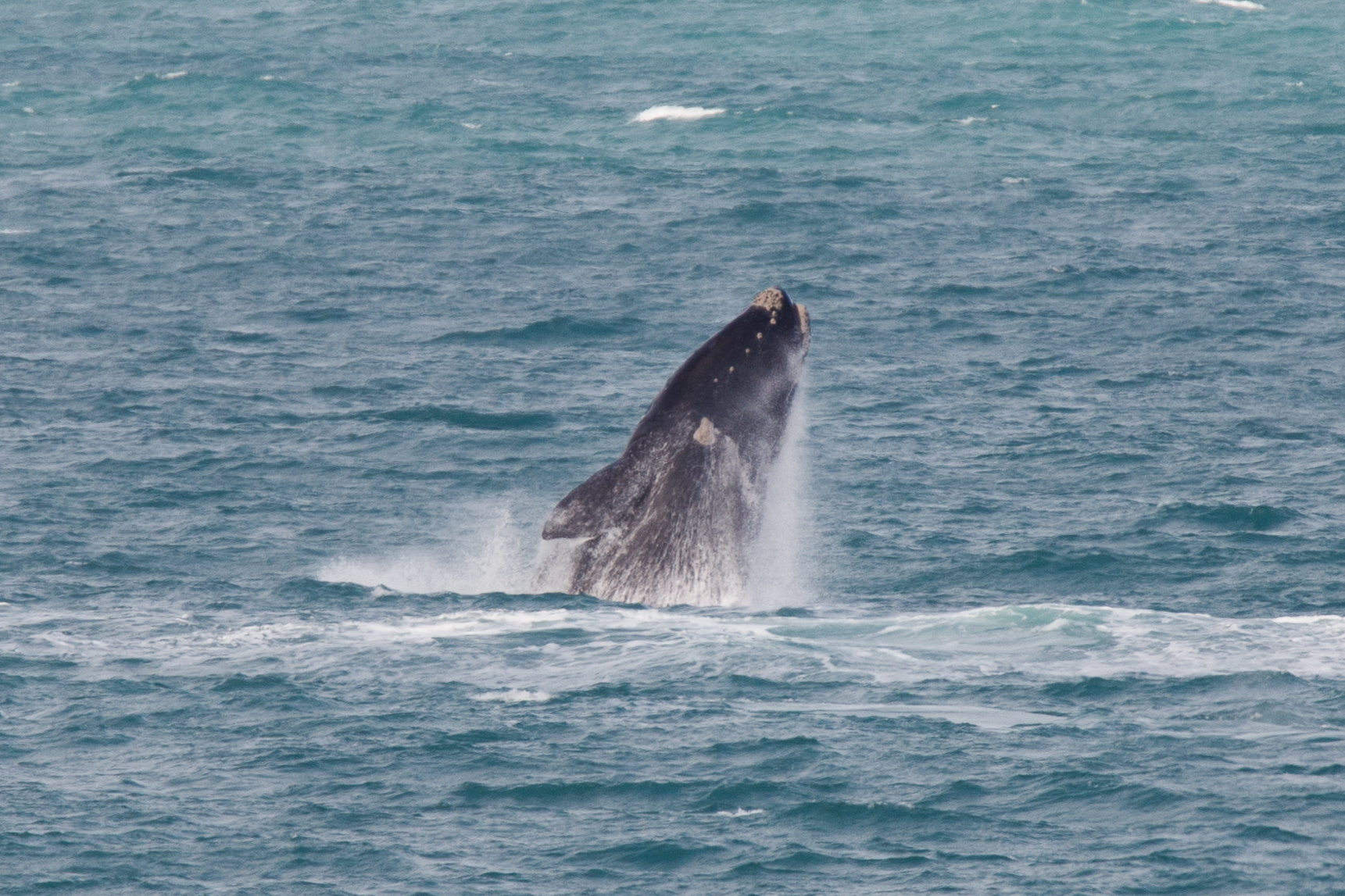
Male right whales have the largest testes of any creature on Earth. (Photo: robdownunder, Flickr CC BY-NC-ND 2.0)
HARDT: Oh my goodness yes! [LAUGHS]
CURWOOD: So this brings us to one of the most scientifically provocative parts of your book and that is probing the scientific mysteries of the vagina. This part of the anatomy which given that guys are guys tend to pay attention to what you can see rather than what you can't see.
HARDT: This is true and it's wonderful because we're at point now where there is growing recognition of the importance of the female body and anatomy and behavior in influencing the outcome of reproduction. For a long time, females were thought of as sort of the passive receivers of sperm and that was really it, especially once sex had happened. So, for internal fertilizers it was thought that once the male gained access to the female and deposited his sperm, again there might be some sperm competition going on but the female really had no control, and a researcher named Dr. Sarah Mesnick who works out of the Southwest Fisheries Science Center in San Diego has been made a fantastic mentor in walking me through this marvelous world of whale vaginas in particular.
What they found is rather than thinking of a whale vagina as a single tube leading into a uterus, it's actually like a maze. They find twist and turns and blind alleys and false flaps and trapdoors and I remember Sarah saying to me, "When we first looked in this thing, all I could think of was how the heck does a sperm find his way to the cervix? How do they even know where to go?" Again, like Sarah says, that "last mile", it's female territory, it's their home turf so they're controlling a lot more than we realized.
CURWOOD: Talk to me about sex change. You say that fish like the Gobi and clown fish can go both ways.
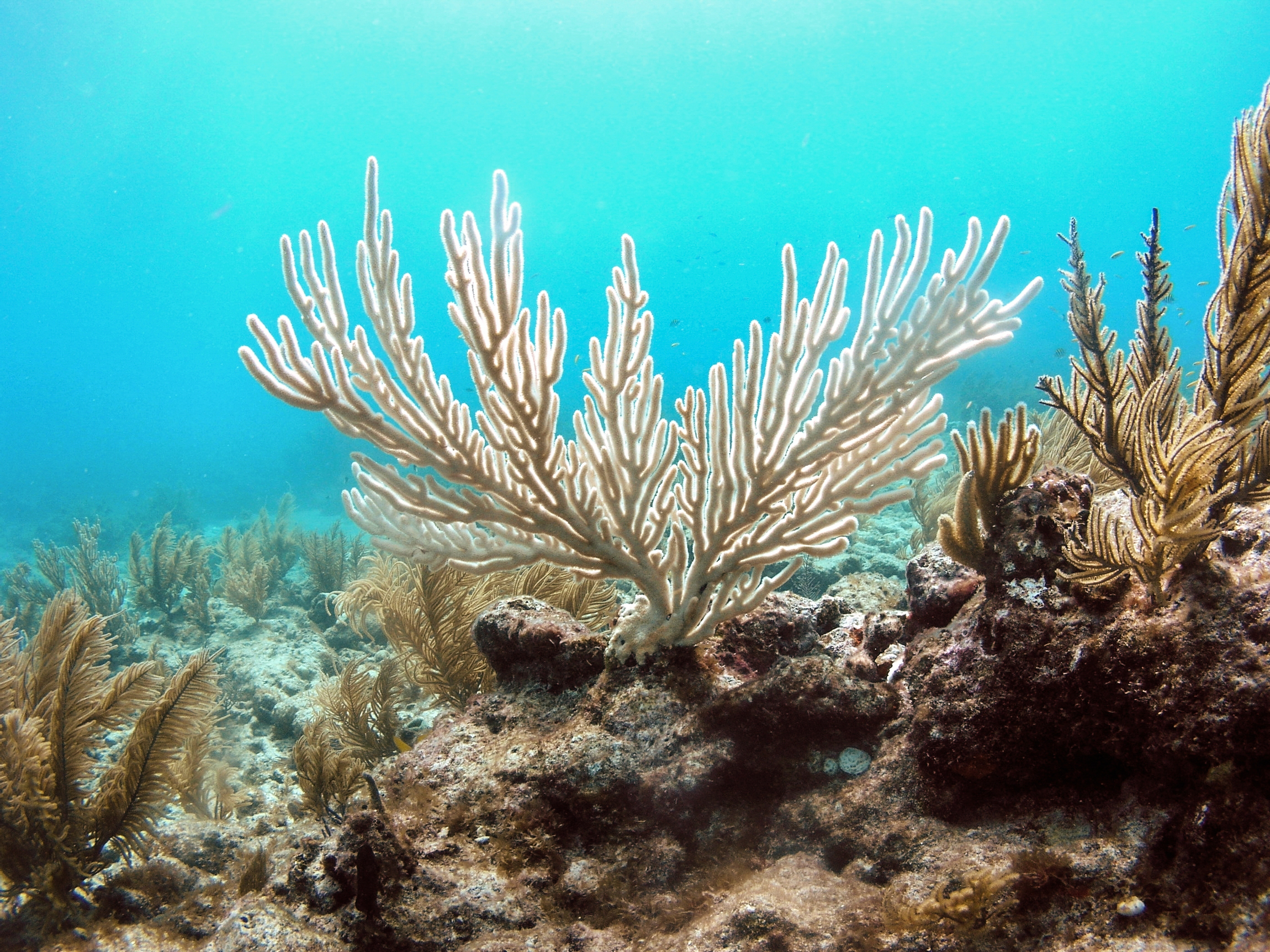
As Earth’s oceans become more polluted and acidic, sea creatures have a harder time sensing their mates and successfully reproducing. (Photo: Kelsey Roberts/U.S. Geological Survey, Flickr CC0 1.0)
HARDT: Yeah, so sex change is a really common strategy in the ocean, oysters do it, shrimp do it, many, many different fish do it. And what does, is it works really well to help maximize the amount of babies you can make. So in systems where males can dominate females, but they need to be big to do so, it makes sense when you're small and a little bit less aggressive to be a female, you can reproduce as a female, and then once you've grown big and strong and gain some ability to be a dominant male, you switch into to that male role and you can take over a harem, and you can defend a territory, and then you can meet with tons of females and keep your reproductive efforts at a max. In other systems it makes sense to actually go the opposite direction. So, for example, for some species like a clown fish, who get together and stay in relatively monogamous pairs inside their little anemone home - there's a male and a female - it makes sense that you would want to start as a male, hook up with a big female, you're a small male, you can still mate. But then when your bigger female passes on, you can take on the big role, grow into being a large female and take a smaller male along with you. A smaller male has enough sperm to fertilize all the eggs a big female can produce.
What's really crazy when you think about is I don't think any of us would choose to go through puberty twice, right?
[LAUGHTER]
I mean, let's not do that. But for these fish it's really effective, it's also again really important for management because when you have a sex changing species you have to be managing not only the number of fish that are there, you have to make sure you're monitoring the sex ratio and when we start pulling these fish out, we're triggering them to change sex perhaps when they might not otherwise, and this could have huge consequences for the amount of reproduction and the success of reproduction.
CURWOOD: Marah, before you go, if you were to come back as a sea creature, based on your studies of underwater erotica, which creature would you choose to be?
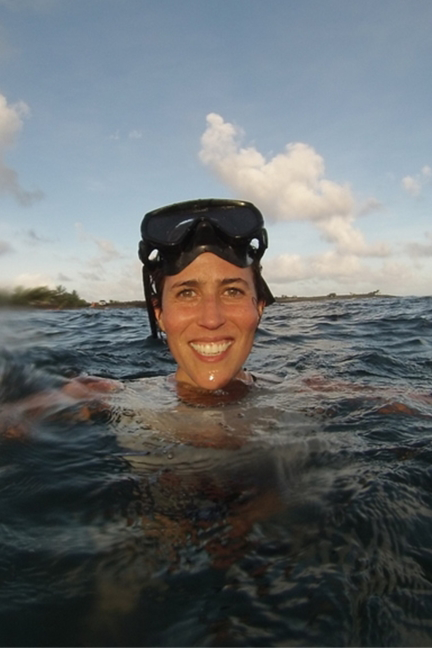
Marah Hardt is a marine biologist, author and research scientist working towards solutions for ocean conservation. (Photo: Joe Laughlin)
HARDT: [LAUGHS] Man, that is such a loaded question. Who would I be? I think that the corals really create a magical spectacle. Coral sex is almost like being a musician who gets to play in this incredible orchestra, and all year long you're practicing your part, right, you're the violinist, or the cellist, and you're practicing your part and just making sure that you have every note perfect and everything is ready to go and then you have this one grand night under the full moon in the tropics and you all come together and you play the piece and it crescendos and everything takes off at once. To me that that would be a pretty cool, yeah, a very cool way to reproduce and send off the next generation in this beautiful ethereal group activity that requires a lot of coordination, but you don't have to get too dirty, too messy.
CURWOOD: So once a year with passion! [LAUGHS]
HARDT: Once a year with passion and then everyone leaves you alone, you can go back to doing what you want to do!
CURWOOD: Marah Hardt's new book is called Sex in the Sea: Our Intimate Connection with Sex-changing Fish, Romantic Lobsters, Kinky Squid and Other Salty Erotica of the Deep. Thank you so much Dr. Hardt taking the time with us today.
HARDT: Oh, thank you so much for having me. This was a pleasure.
Links
Marah Hardt’s book Sex in the Sea
Living on Earth wants to hear from you!
Living on Earth
62 Calef Highway, Suite 212
Lee, NH 03861
Telephone: 617-287-4121
E-mail: comments@loe.org
Newsletter [Click here]
Donate to Living on Earth!
Living on Earth is an independent media program and relies entirely on contributions from listeners and institutions supporting public service. Please donate now to preserve an independent environmental voice.
NewsletterLiving on Earth offers a weekly delivery of the show's rundown to your mailbox. Sign up for our newsletter today!
 Sailors For The Sea: Be the change you want to sea.
Sailors For The Sea: Be the change you want to sea.
 The Grantham Foundation for the Protection of the Environment: Committed to protecting and improving the health of the global environment.
The Grantham Foundation for the Protection of the Environment: Committed to protecting and improving the health of the global environment.
 Contribute to Living on Earth and receive, as our gift to you, an archival print of one of Mark Seth Lender's extraordinary wildlife photographs. Follow the link to see Mark's current collection of photographs.
Contribute to Living on Earth and receive, as our gift to you, an archival print of one of Mark Seth Lender's extraordinary wildlife photographs. Follow the link to see Mark's current collection of photographs.
 Buy a signed copy of Mark Seth Lender's book Smeagull the Seagull & support Living on Earth
Buy a signed copy of Mark Seth Lender's book Smeagull the Seagull & support Living on Earth

